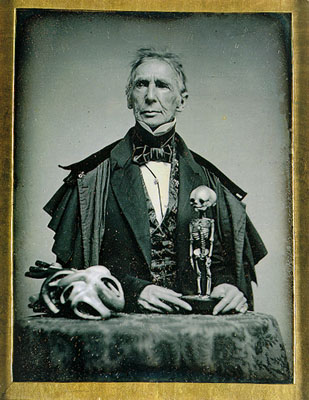John Collins Warren
(1778 - 1856)


"Anaesthesia had been the dream of many surgeons and scientists, but
it had been classed with aerial navigation and other improbable inventions."
[from Ether by John Collins Warren]
"This case is remarkable in the annals of surgery. It was the first surgical operation performed under the influence of ether. Dr. Warren had been applied to by Mr. Morton, a dentist, with the request that he would try the inhalation of a fluid which, he said, he had found to be effectual in preventing pain during operations on the table. Dr. Warren, having satisfied himself that the breathing of the fluid would be harmless, agreed to employ it when an opportunity presented. Now occurring in private practice within a day or two, he determined to use it on this patient.Before the operation began some time was lost in waiting for Mr. Morton, and ultimately it was thought he would not appear. At length he arrived and explained his detention by informing Dr. Warren that he had been occupied in preparing his apparatus, which consisted of a tube connected with a glass globe. To the surprise of Dr. Warren and the other gentlemen present, the patient did not shrink nor cry out.
He then proceeded to apply, and after four or five minutes the patient appeared to be asleep, and the operation was performed, as herein described. To the surprise of Dr. Warren and the other gentlemen present, the patient did not shrink nor cry out, but during the insulation of the veins he began to move his limbs and utter extraordinary expressions, and these movements seemed to indicate the existence of pain; but after he had recovered his faculties, he said he had experienced none, but only a sensation like that of scraping the part with a blunt instrument, and he ever after continued to say he had not felt any pain.
The results of this operation led to the repetition of the use of ether in other cases and in a few days its success was established, and its use resorted to in every considerable operation in the city of Boston and its vicinity."
For his public demonstration of etherization at Massachusetts General Hospital on 16th October 1846, dentist and half-educated medical student William Morton liaised with Staff Surgeon Henry Bigelow. They secured the services of the same distinguished physician who had operated during Horace Wells' ill-fated demonstration of nitrous oxide anaesthesia, Senior Surgeon John Collins Warren.
At 68 years old, Warren was an implausible figure to preside over a medical revolution. Over thirty years before, in 1815, he had succeeded his father as Professor of Anatomy and Surgery. In 1782, his father had helped to found Harvard Medical School; and the younger Warren himself served as Dean of the Medical School between 1816 - 1819. Adding to his stature, John Collins Warren played a leading role in establishing the first medical journal in New England, the Boston Medical and Surgical Journal. The journal was first published in January 1812; it is the ancestor of the present New England Journal of Medicine.
Thus Warren's eminence and distinguished reputation guaranteed Morton a sizeable if not necessarily sympathetic audience. Warren's expertise as a surgeon increased the likelihood of a successful outcome - if Horace Wells' mistake could be avoided. By reportedly first suggesting to Morton that he use ether rather than nitrous oxide, Professor Charles Jackson could stake his claim to the credit too.
On 17th October, Warren invited Morton to administer "The Letheon" to his patient, a timid 52 year-old printer named Edward Gilbert Abbott. Abbott had a congenital vascular tumour just below his left mandible. To reassure the anxious patient of The Letheon's safety and efficacy, Morton had taken along to the amphitheatre Eben Frost, the Boston merchant whose ulcerous tooth Morton had extracted in his office on 30 September.
The operation under Letheon/ether anaesthesia lasted only around ten minutes. The patient was seemingly unconscious for its duration. After Warren had finished ligating the malformation on the insensible Abbott's neck, the elderly surgeon remarked to his audience, it is said with tears in his eyes: "Gentlemen, this is no Humbug". The era of painless surgery had begun.
Warren was a widely known and respected figure in medicine. Without his willingness to try the new procedure in public, the anaesthetic revolution might have been delayed, conceivably for years. Bigelow's masterly paper, Insensibility during surgical operations produced by inhalation (1846), sealed Morton's triumph and vindicated Warren's judgement.
On December 7, Gilbert Abbott was able to leave hospital, alive and well, after a stay of 52 days.
HOME
Search
Resources
Snapshots
Utopian Surgery
John Collins Warren
Refs and Further Reading
Anaesthesia and Anaesthetics